You know those Cinderella-style films such as Pretty In Pink where the cash-poor leading lady purchases a rummage sale dress and proceeds to turn it into something stunning? That was American Motors for basically every year of their existence.
With cars like the Javelin and especially the later Concord and Eagle, the design staff led by Dick Teague proved they could mix rather meager ingredients and turn them into appetizing dishes. While AMC’s compact cars benefitted from the team’s skilled attention, the brand let its “big” Matador flounder and die without even trying to sprinkle on the fairy dust. In fact, Teague and team seemed to inexplicably go out of their way to make the last version even less appealing.
What if, visually and mechanically, American Motors instead tailored its also-ran full-size Matador as a bargain-basement Cadillac, or at least a high-end Buick? I’ll try to visualize that.
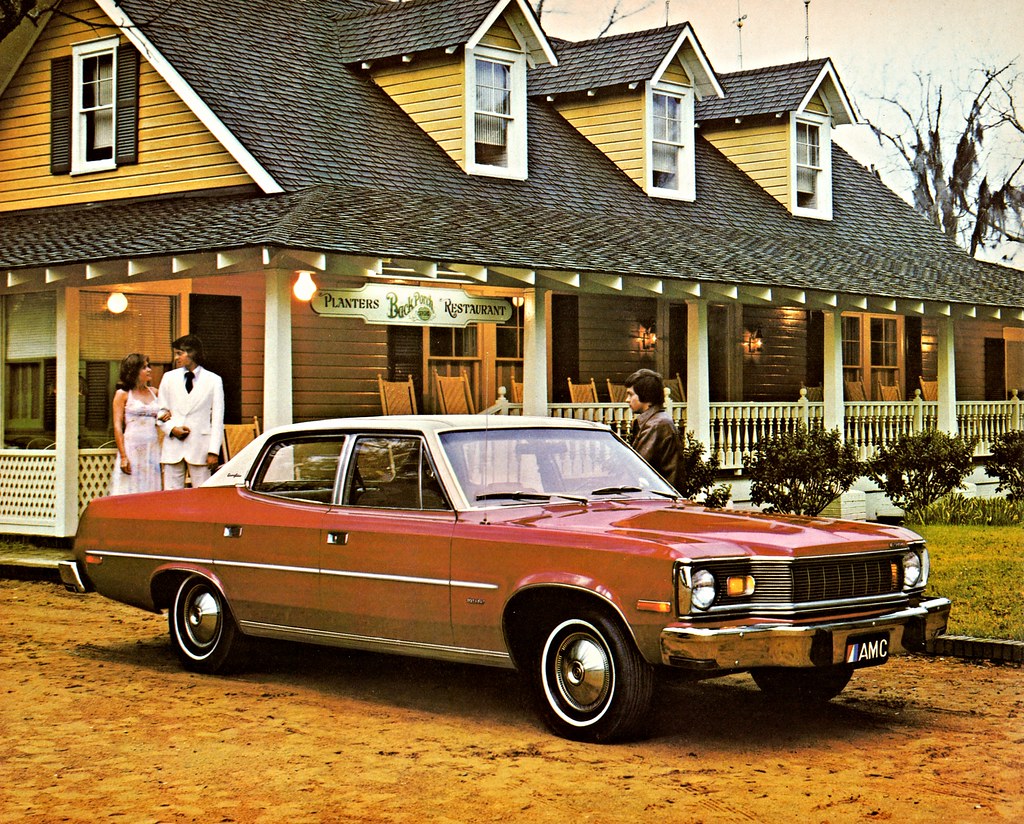
Geez, look at that thing. Maybe this is a bigger task than I want to take on. Pray for me.
Bargain-Basement Makeover Challenge!
The last independent automaker’s struggle to survive was a David and Goliath battle, or rather David versus Goliath and his two just-as-big brothers, Billy and Stephen Goliath. With just a couple of cars and limited cash, they needed to meet as much of the automobile market as they could, which meant highly creative solutions.
Let’s take the new-for-1970 compact Hornet. The car itself was already made as economically as possible by doing things like using the same roof stampings for both two- and four-door models. That alone saved millions of dollars, money that Ford or GM might not have thought twice about spending, but AMC absolutely would.

Despite the Hornet being a compact, American Motors realized they needed something even smaller to counter the latest offerings vying for budget-minded customers’ dollars, such as Japanese subcompacts and the Ford Pinto. Here’s the solution that I wrote about a while back:
To develop this new little import fighter, they had the kind of development dollars that GM or Ford might spend on a taillight refresh. Ah, but American Motors had an ace in the hole with design leader Richard ‘Dick’ Teague, a man who could do more with next-to-nothing than the Big Guys could do with the GNP of Tunisia.
Apparently, Teague was flying back home to Wisconsin on a Northwest Orient flight and thinking about this seemingly impossible challenge when an idea hit him. For whatever reason, Dick didn’t have any paper handy, so he grabbed the next best thing he could- the air sickness bag from the seatback in front of him and scribbled out his rough concept:
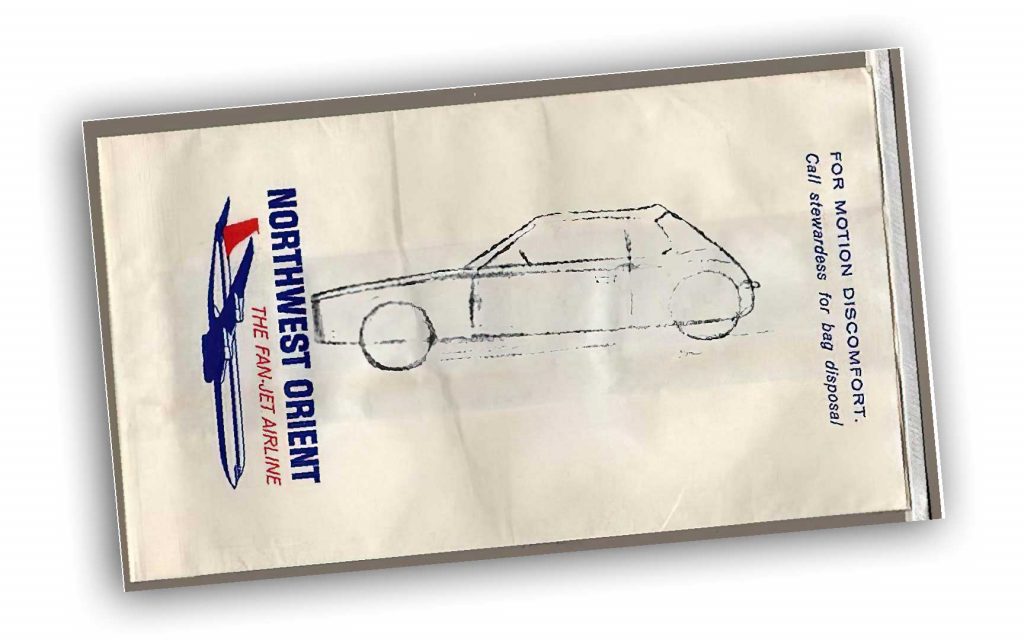
Earlier, Teague had taken the Javelin pony car and chopped out a foot from the wheelbase to turn it into the AMX ‘sports car’, so it made sense in his mind to do a slicing with a cleaver on the 1970 Hornet. The design team took a Hornet coupe and removed ten inches from the wheelbase and ten inches out of the overall length to make a car an inch shorter than the Beetle. Still, the entire front section of the Hornet and the whole drivetrain was retained, so the tooling and time investment was remarkably minimal for such a different car.

AMC knew that it was a rather odd-looking creation, but so was the Beetle. That was part of the appeal. “Nobody would have paid attention if it had looked like one of the Big Three” said Teague. In fact, the company doubled down on this weirdness by making a goofy ‘Gremlin’ character on the badge and even releasing the car on April Fool’s Day.
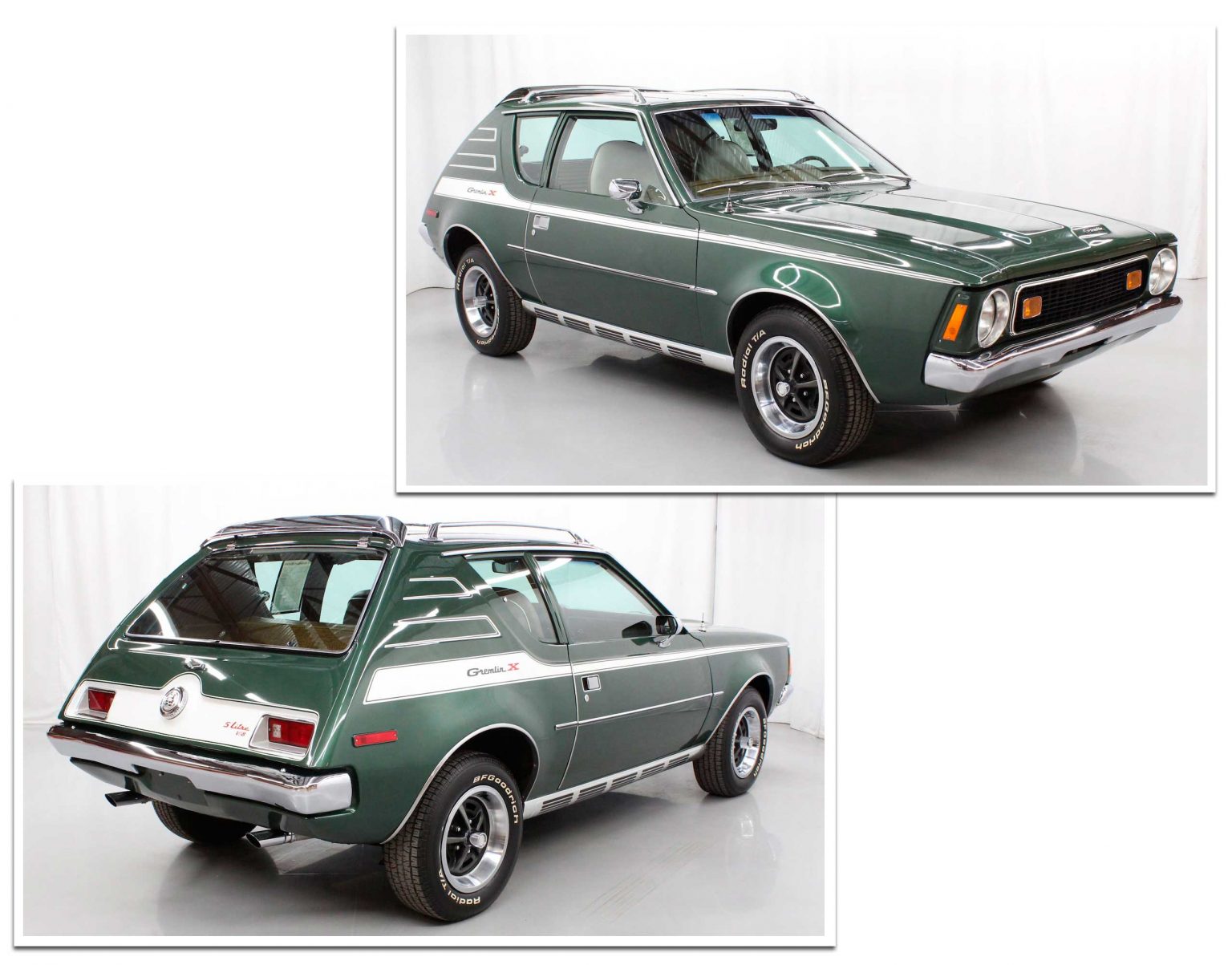
Surprisingly, the Gremlin did sell relatively well, with 670,000 examples leaving AMC dealerships during its 1970-1978 run.
The Hornet was still around in the late seventies. By then, it was not only looking dated, but it appeared highly lackluster next to the glitzier baroque offerings from AMC’s far-better-funded competitors in the disco era. Once again, Dick Teague’s team struck gold:
Lacking the funds to make an all-new car, they had a brilliant vision; dress up the old Hornet to look as fancy as possible and give it a new, fancier-sounding name: the Concord. Body-colored hubcaps, vinyl roof, plush seats and even a glowing digital clock were things you’d typically have to buy a much larger or far more expensive car to get.
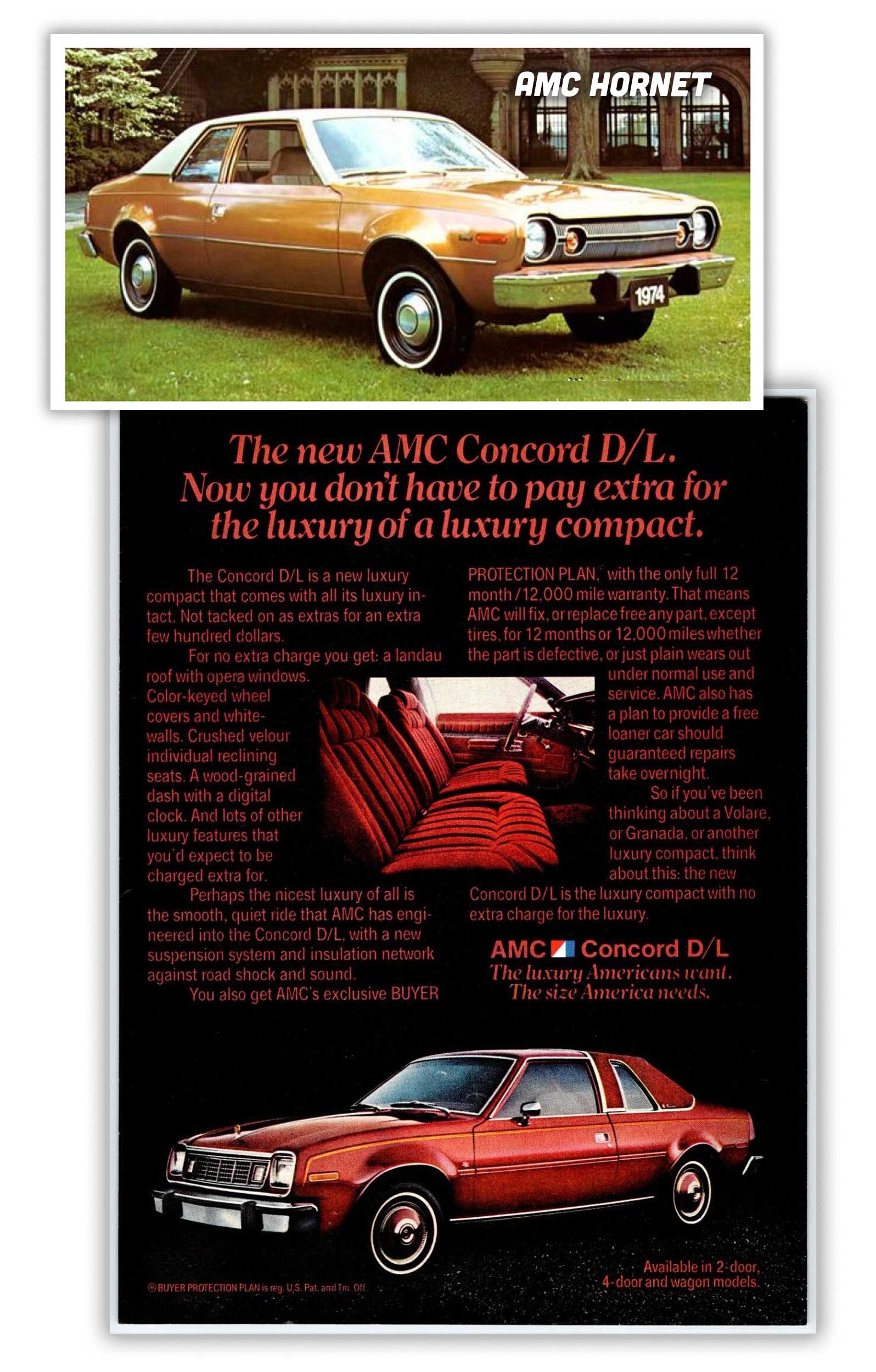
These extras likely cost American Motors very little in parts and development, yet even to our jaded eyes today, the Concord’s styling makes it hard to clock as a Hornet with a bunch of crap stuck onto it.
AMC was famously one of the first car makers to violate a sort of gentleman’s agreement and directly compare their products to the competition in ads. This one below really tells the story, especially when you see those stripped-out Big 3 cars on dog dish hubcaps for more money.

AMC wasn’t done. For 1980, the always-innovative brand introduced the first crossover all-wheel-drive series of vehicles to the market (save your breath telling me about Subaru wagons since those had no central differential and part-time four-wheel drive). Was this a clean sheet of paper new car? Hell no; where was AMC going to find a few hundred million bucks lying around? No, they used all they had to work with, which was the old Hornet-based Concord. Still, despite being a decade old, with tough-looking flared fenders and a four-shot rectangular-headlight nose the Eagle came out a lot better than it had any right to do.

Still, you have to believe that AMC was missing out on a more lucrative market: bigger cars have almost always meant bigger profits. If American Motors worked its magic with this compact car, why couldn’t they have at least tried to do the same thing with their larger car?
The Bullfighter Gets Skewered
Originally sold under the “Rambler” name, American Motors’ products were typically staid, dull cars for staid, dull people. That started to change in the sixties, a metamorphosis that included new-for-1967 mid- to large-sized cars. Stuck with the rather anachronistic “Rebel” name, AMC’s attractive “standard-sized” sedan looked every bit as good as what any of the Big Guys could offer you. I bet Jason likes how the side marker light blends in with the door handle:
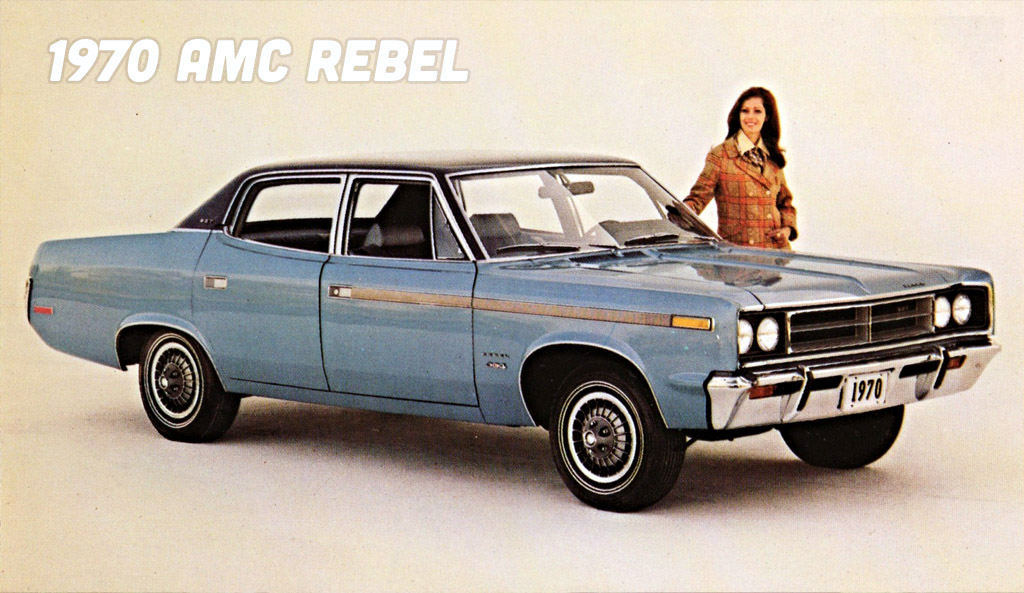
For 1971, AMC did a facelift that included a new name – Matador – and a really nice-looking and aggressive grille that looped in with the front bumper in a style that AMC kept for several years.
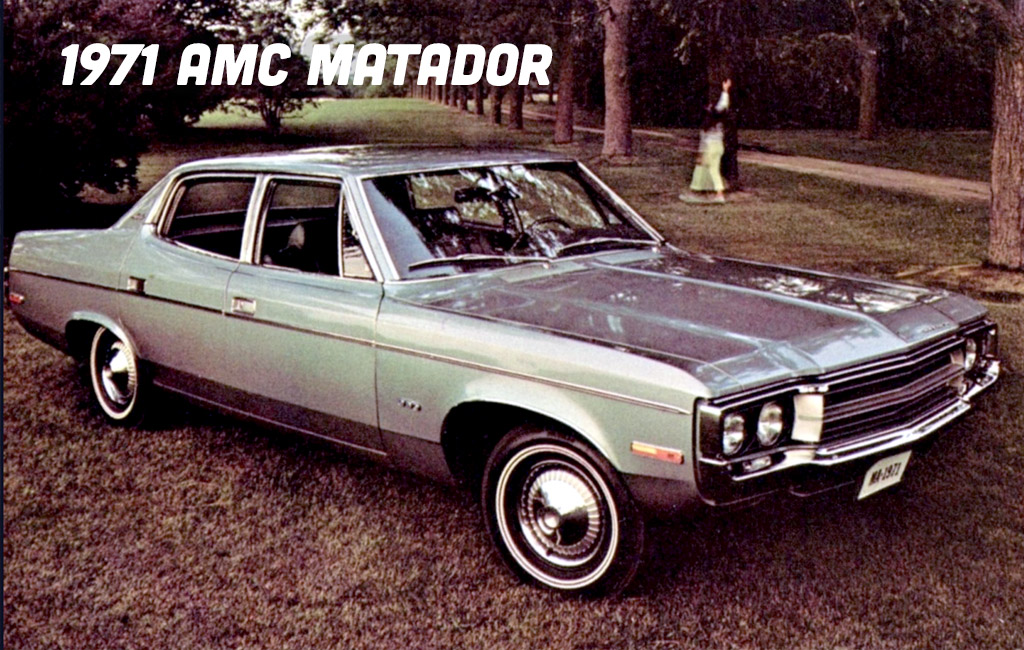
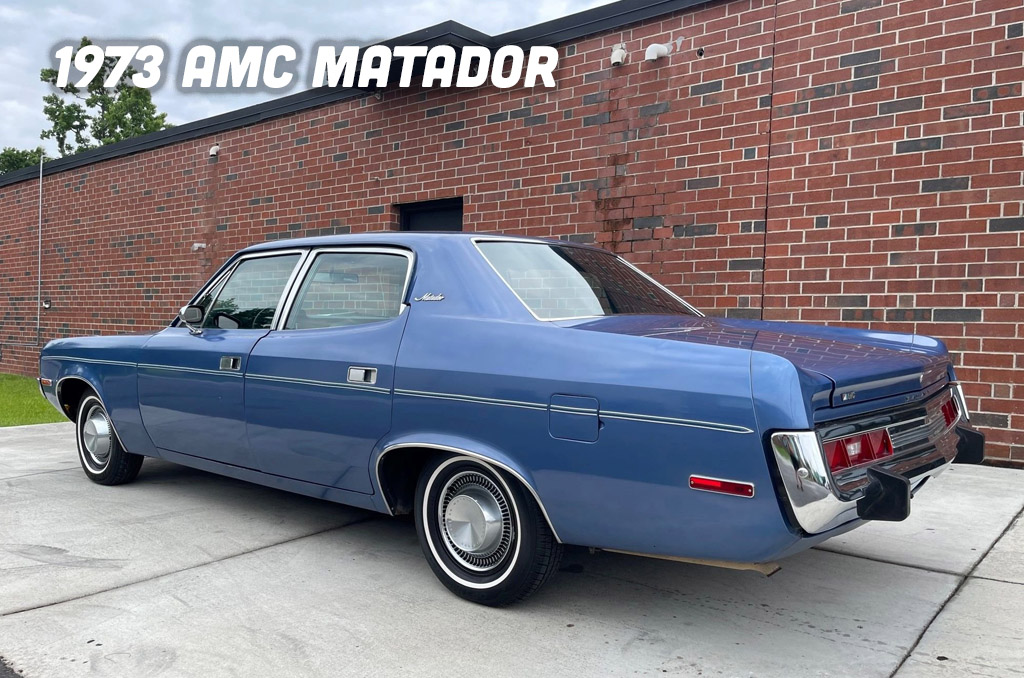
The fact that Matadors appeared as the cop cars in the reruns of ADAM-12 you caught as a kid just added to the cool factor. Those new Fiats across the street from the dealership below are already rusting, by the way.
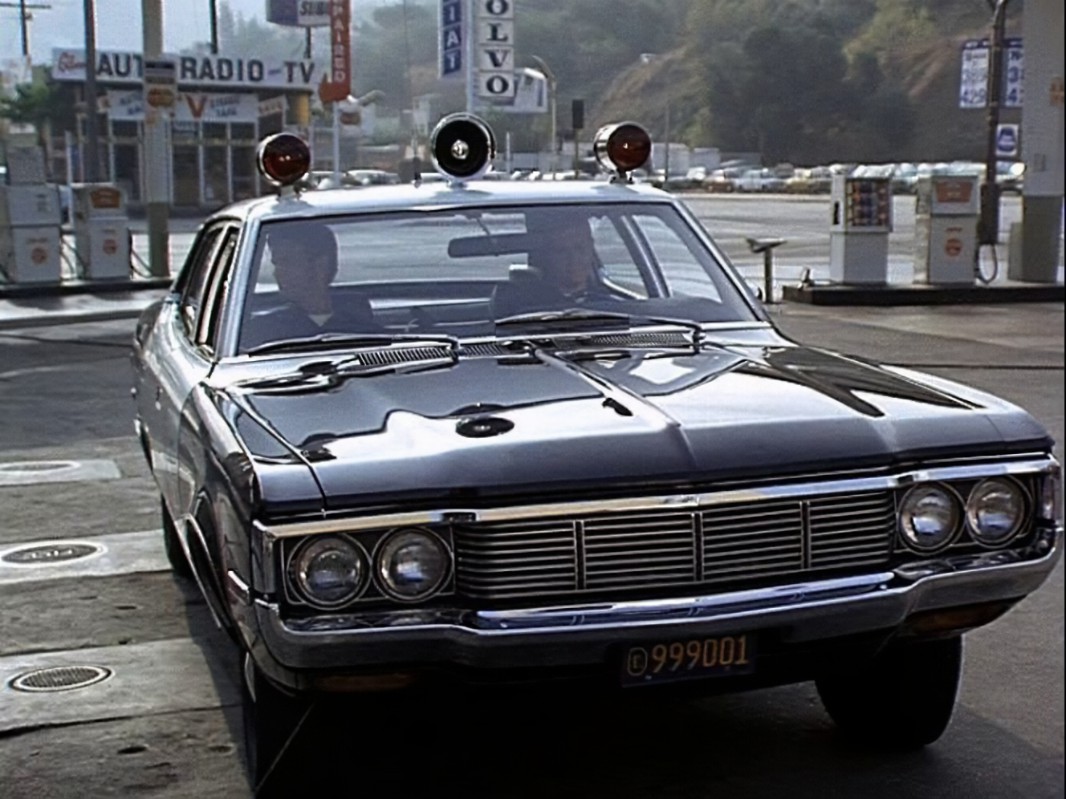
Then, the unthinkable happened. For 1974, the dreaded five-mile-per-hour bumper standards went into effect, and many US-market cars suffered visual disfigurement from the need to add these obtrusive devices. Would the genius of AMC’s Dick Teague save the day once again?
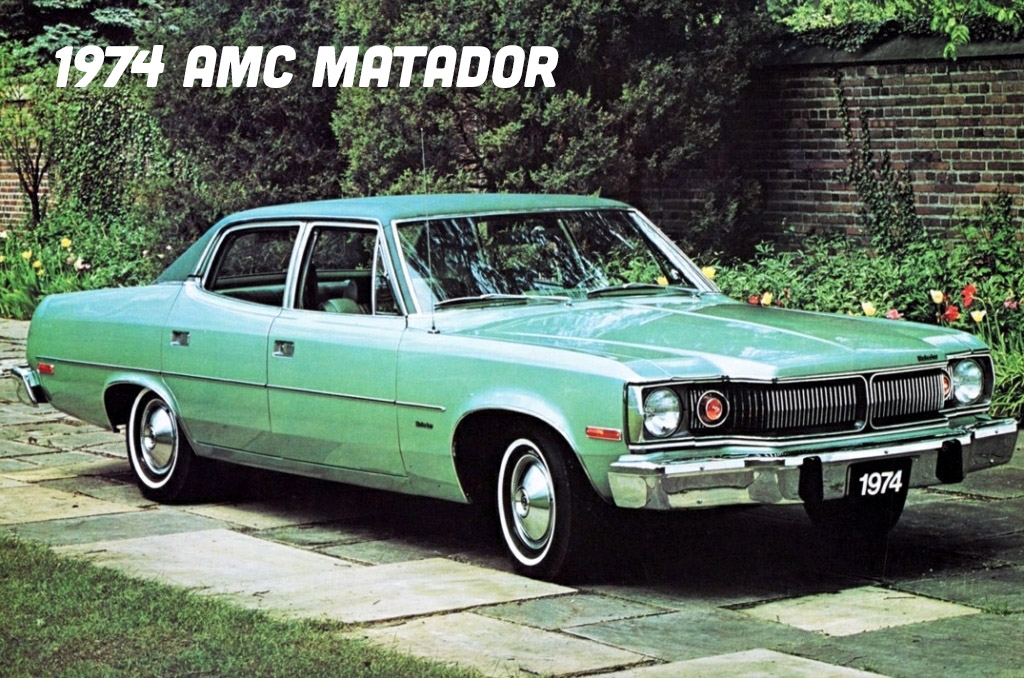
No.
Look at that schnoz! The legally-compliant Matador looked like Pinocchio after telling a whopper of a lie. There are plenty of cars with large “noses,” but the ’74 Matador was Peppa-Pig absurd, and the two small headlamps didn’t help. The shape was also reminiscent of a coffin being dropped where the engine once was, a coffin that did not fit within the space of the original hood. What happened, Dick? How did you ever let this thing get produced? Essentially all of the cool from the early seventies cars had been lost, and now the roof profile and mock-Coke-bottle shape were becoming apparent as sixties holdovers.
Near the end, AMC added a last-gasp “Barcelona” package dolled up with special wheels, two-tone paint, and funky “Spanish themed” interior cloth. Boy, I had to crop this image wide since that nose is so big.
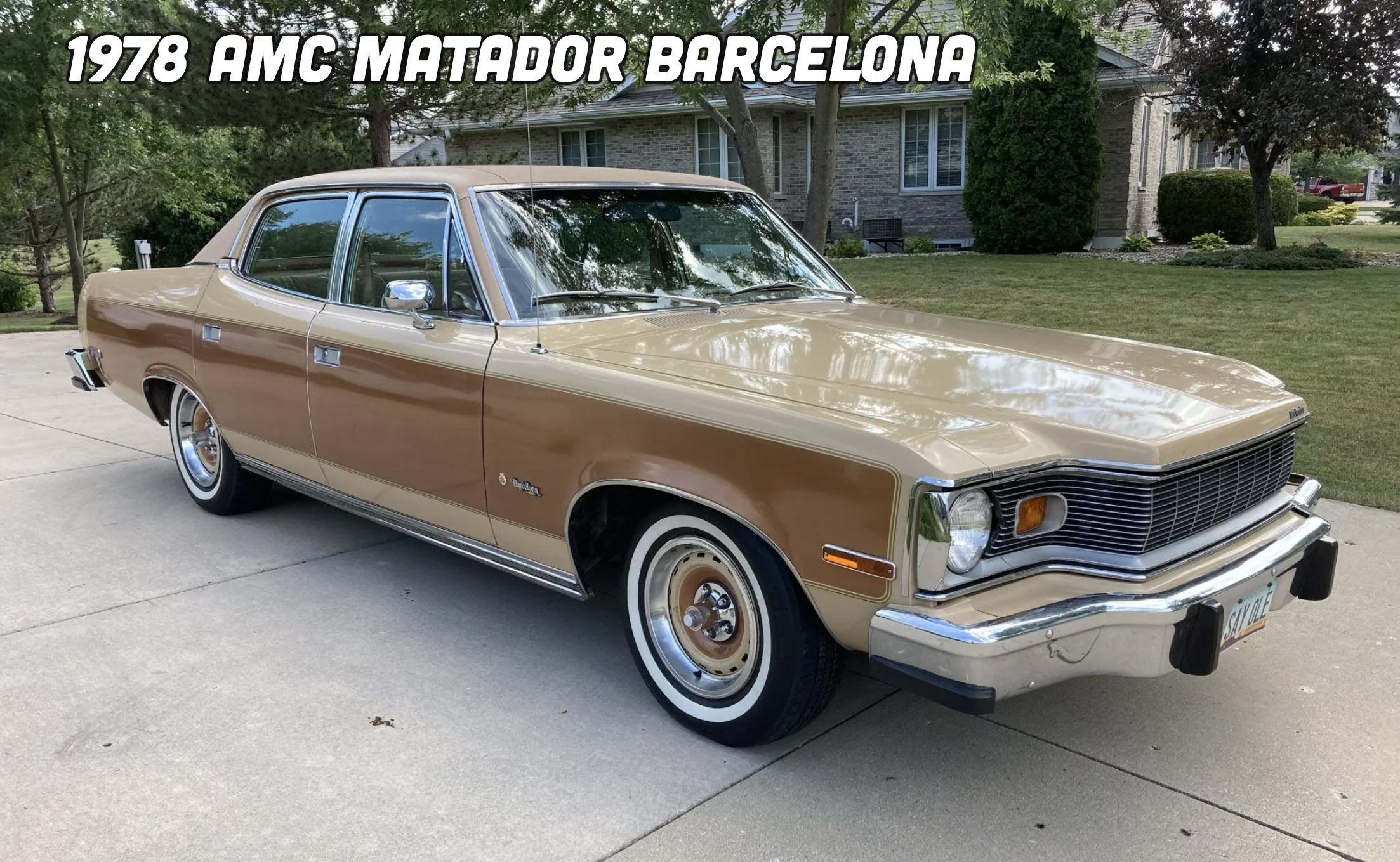
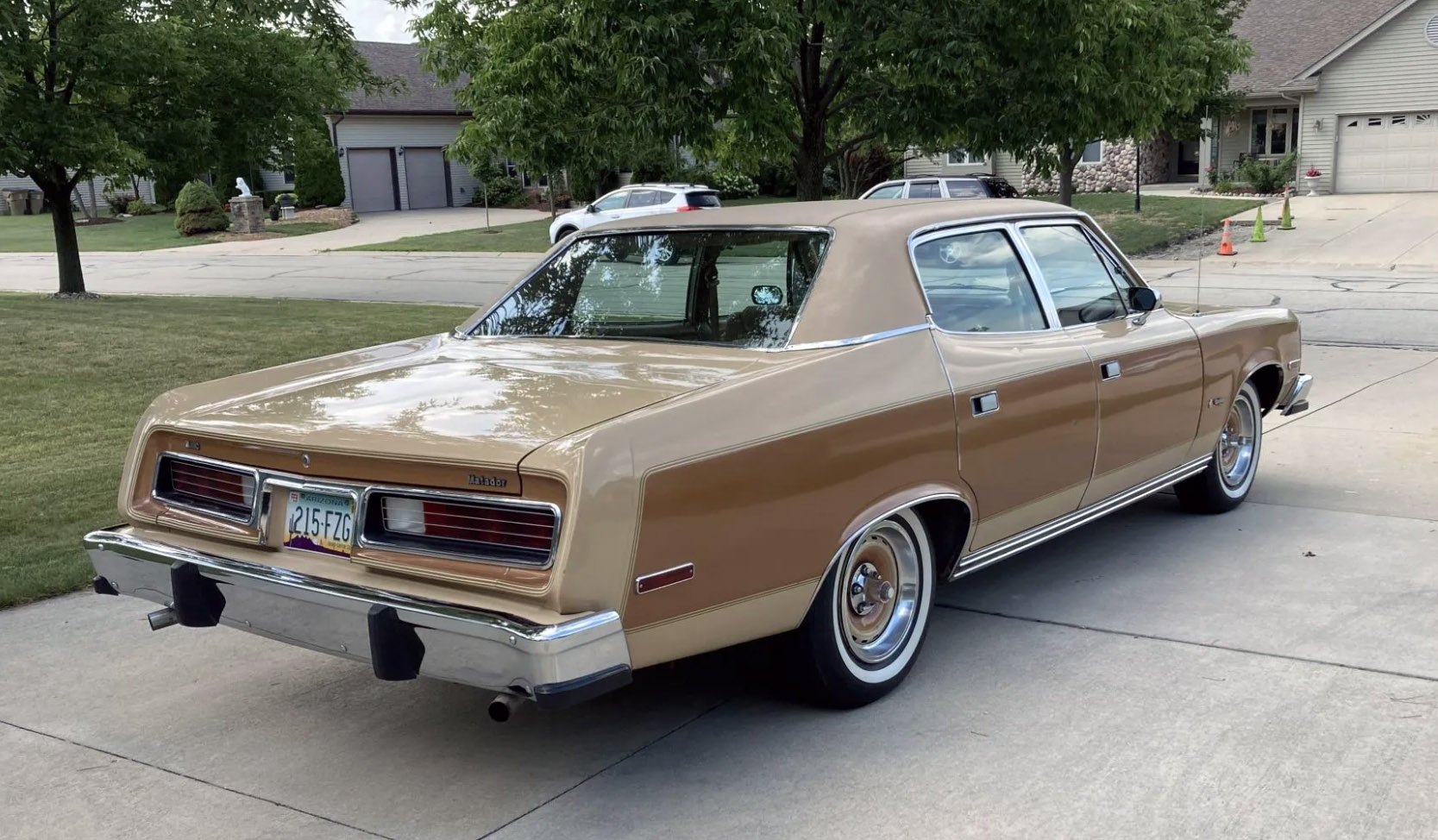
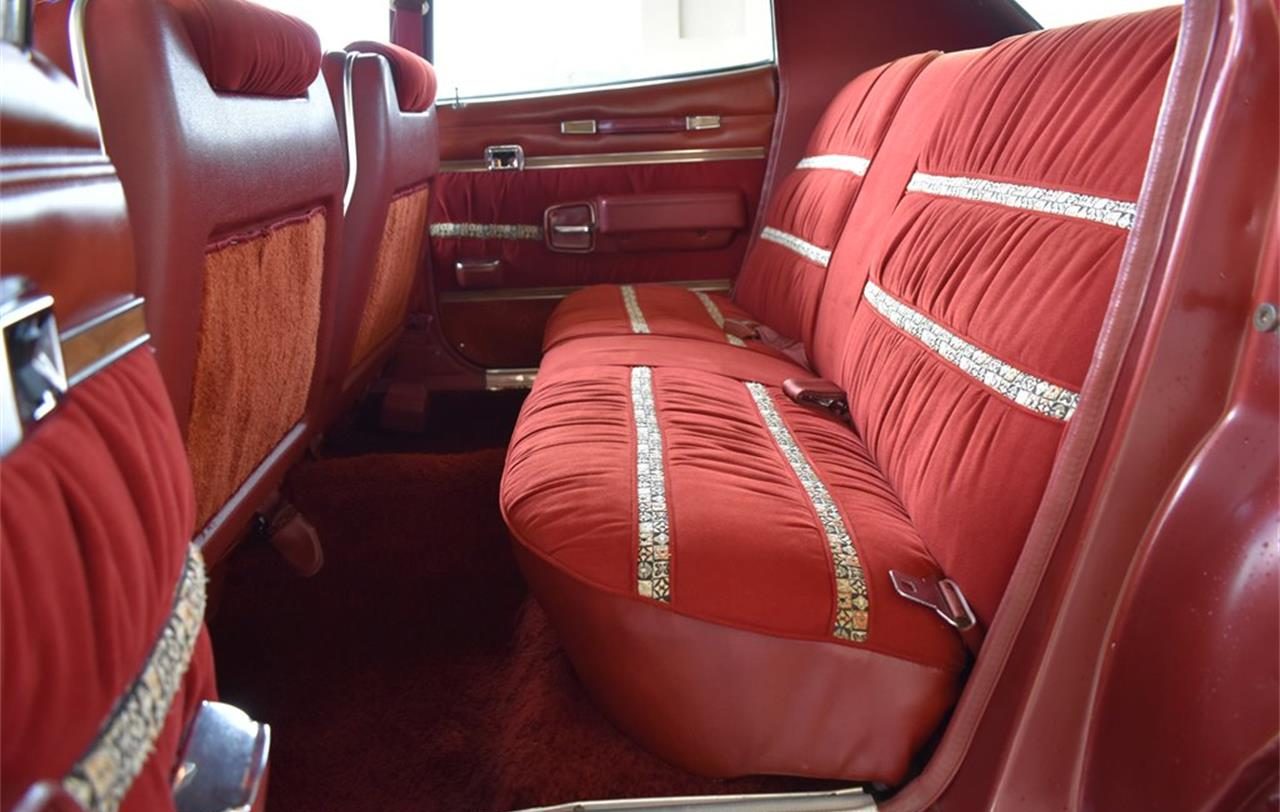
All this did exactly nothing to make the Matador anything more than a distant also-ran to the competition before the model’s demise in 1978 and AMC’s total abandonment of the mid- to large car segment.
It’s too bad, since the unibody American Motors car had coil springs at all four corners, where the Mopars still had cart springs in back. More importantly, the Matador was almost exactly the same length as the new-for-1977 “smaller” full-sized sedans that GM had just spent a reported $600 million to “downsize” to the size the ‘ol Matador already was!
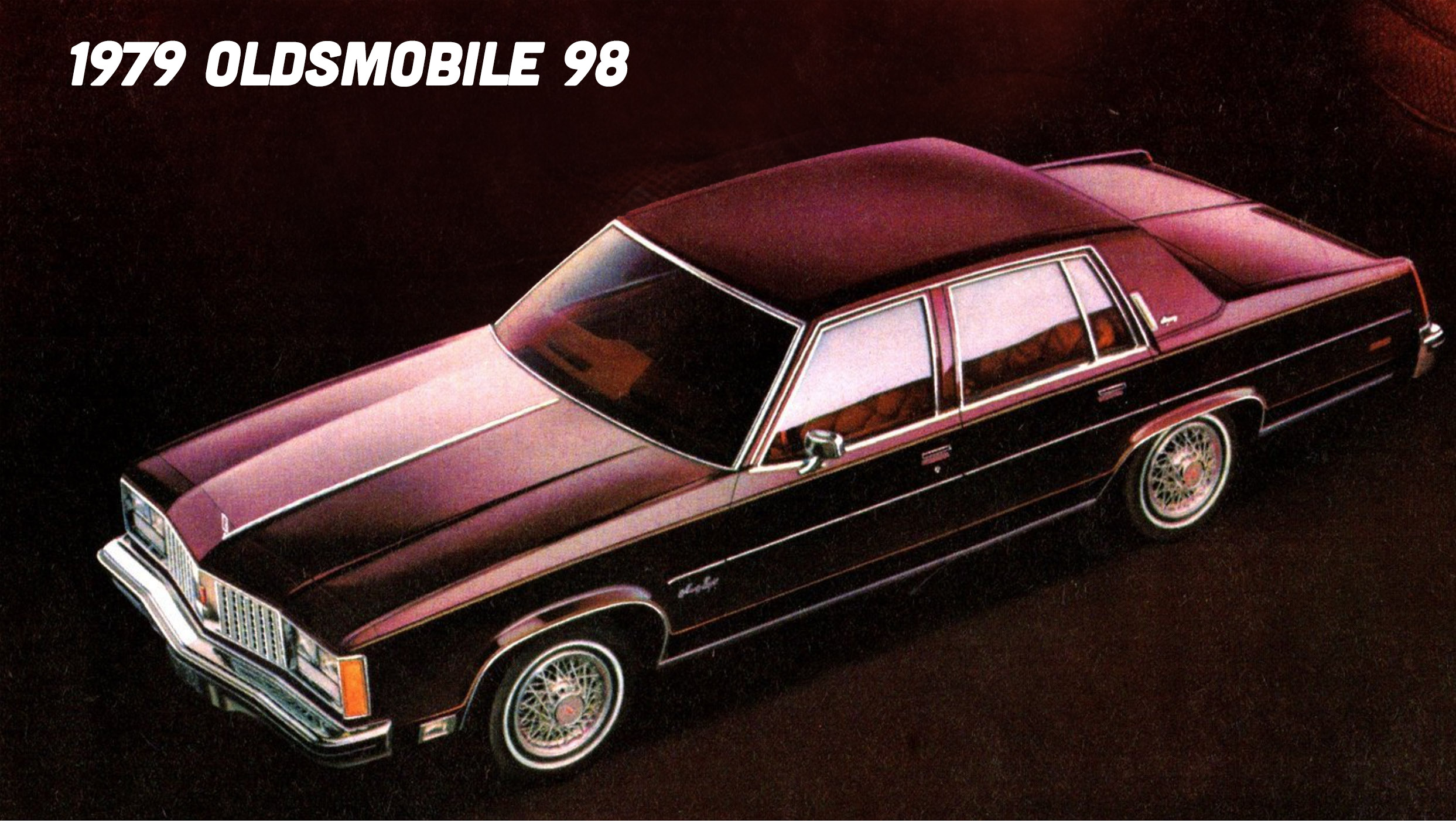

It’s sad that AMC conceded the whole market to the Big Three take and let the Matador die on the vine. Couldn’t they have made a higher-level Concord-style makeover on the Matador and added a few unique twists to make a competitive full-sized luxury sedan? Via The Autopian’s time machine, a real thing that we have, let me step into Dick Teague’s design department circa mid-seventies to see what I can do. Let me just spray some TV tuner cleaner under these potentiometer knobs, set the sliders to 1975, turn the coordinates to Southfield, Michigan, and yank on the comically oversized knife switch …
The Nose Knows
Apparently, AMC cut their always-tight budget by not having any security on Sundays, so I easily snuck into the American Center styling area where, surprisingly, a Matador is parked with some of the proposed updates. It’s obvious even by ’75 that the restyled sedan is a sales dud, so there are sketches on the wall around it of fixes. Ah, but my knowledge of the future lets me apply tricks I know will work at the close of the decade.
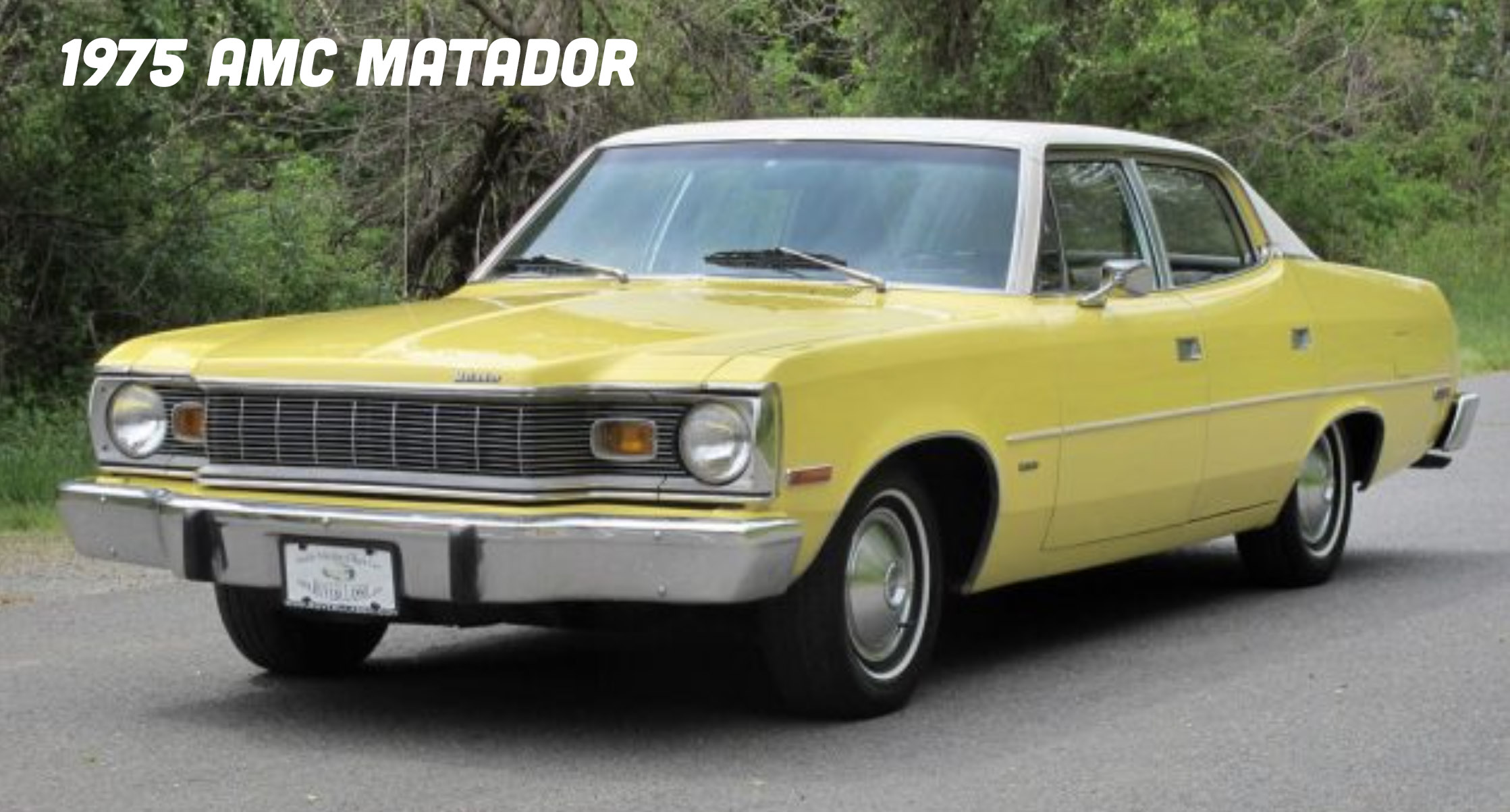
I find tools and turn on a small radio at someone’s desk. As “I’m Not In Love” by 10cc fades into “The Hustle,” I start with unbolting the giant bumpers. I then remove any front and rear body trim not part of the steel fenders, that absurd grille, and the side rub strips.
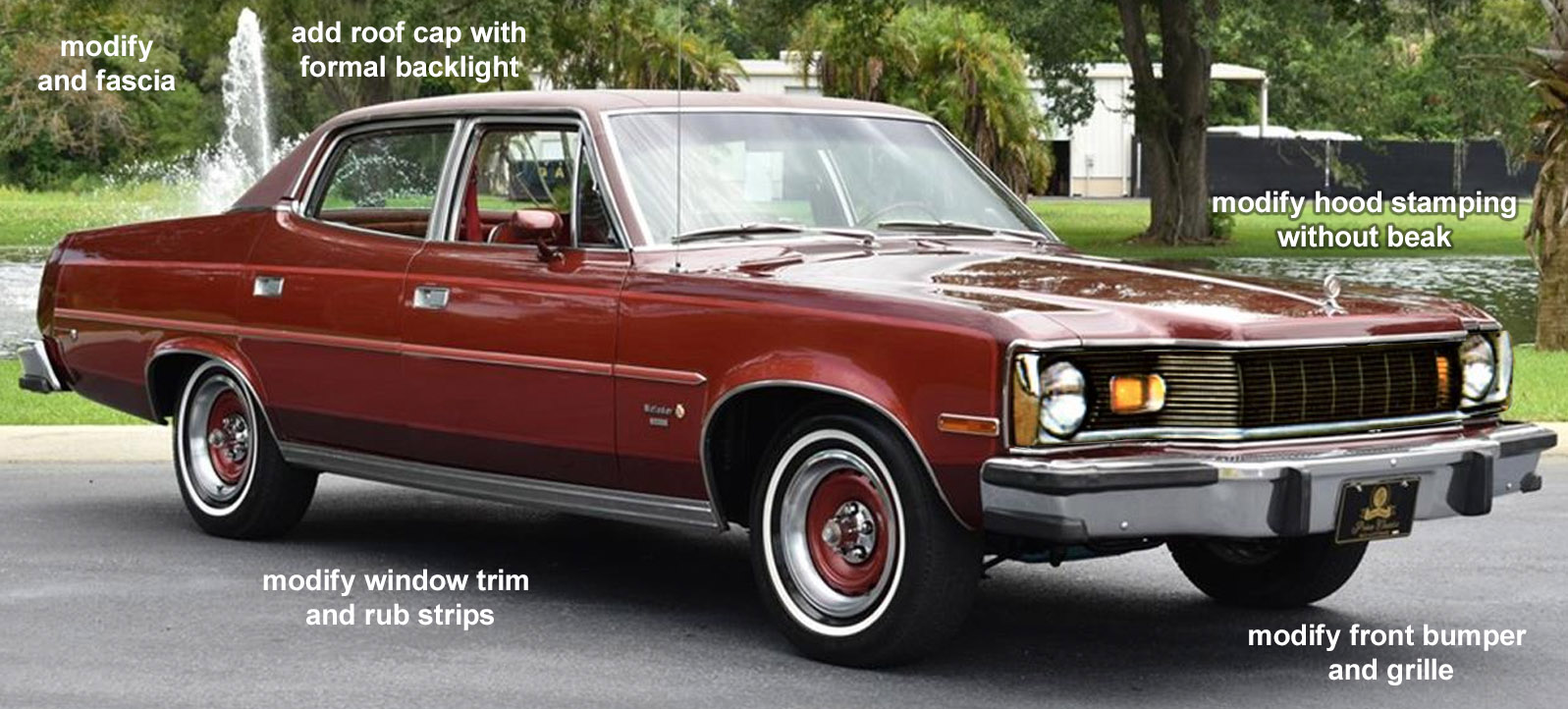
The biggest challenge might be the very dated-looking roof, as most luxury cars were attempting Cadillac Seville-style upright rear windows. The Big Three had this same problem with their cars by the end of the seventies, and their solution was as brilliant as it was awful. The answer was to remove the angled rear glass, then literally rivet and glue a more vertical fiberglass cap and new backlight onto the roof. It’s painfully crude, but once covered in padded vinyl, no one was the wiser. Ford did this with their Lincoln Versailles version of the Ford Granada:
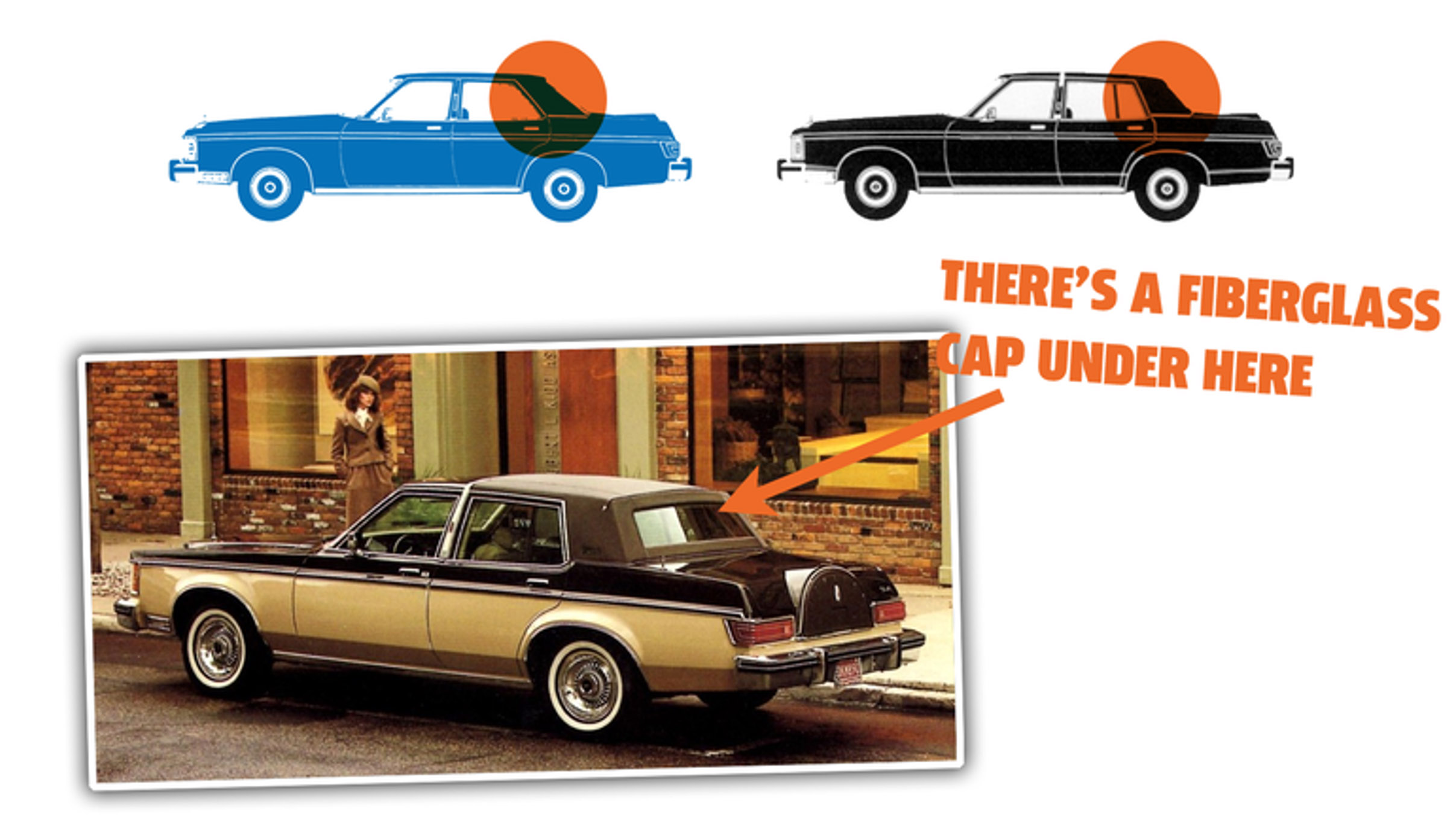
Chrysler committed this same sin on a number of cars:
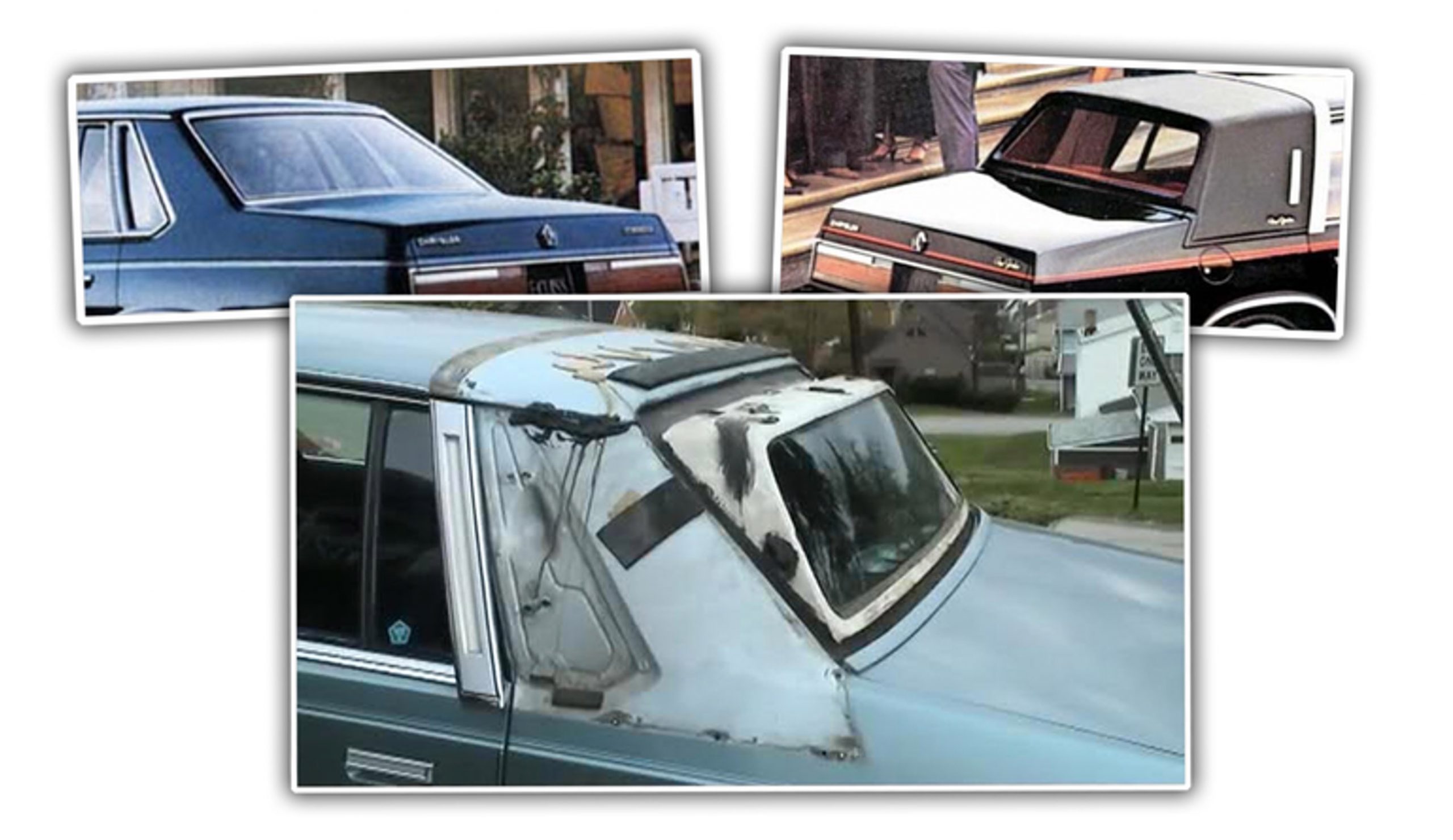
Spotting some sheets of cardboard in the corner, I rather easily mock up flexible body-colored additions to hide the giant five-mile-per-hour ram bars, and feverishly mock up a cardboard cap and cover it in vinyl. Up front, covered headlights and a Mercedes-style grille give the “luxury” look buyers of the era would want. Color-coded wheels, rub strips, and even little rectangles to fill in the classic AMC door handles can’t cost more than a few bucks, but they push land yacht buyers’ buttons as much as the tiny opera lights that I add to the black-accented window trim. Yes, I take off the front vent windows since they instantly date the car by a decade, though I know smokers love them. Sadly, I’ll probably have to suggest a modified rear door stamping if my black trim can’t successfully hide the Coke-bottle upkick.
Here’s what all of that unbolting and riveting and gluing of junk onto the Matador creates: The new AMC Montpelier, a sort of WASPish name that could go nicely with the Concord.
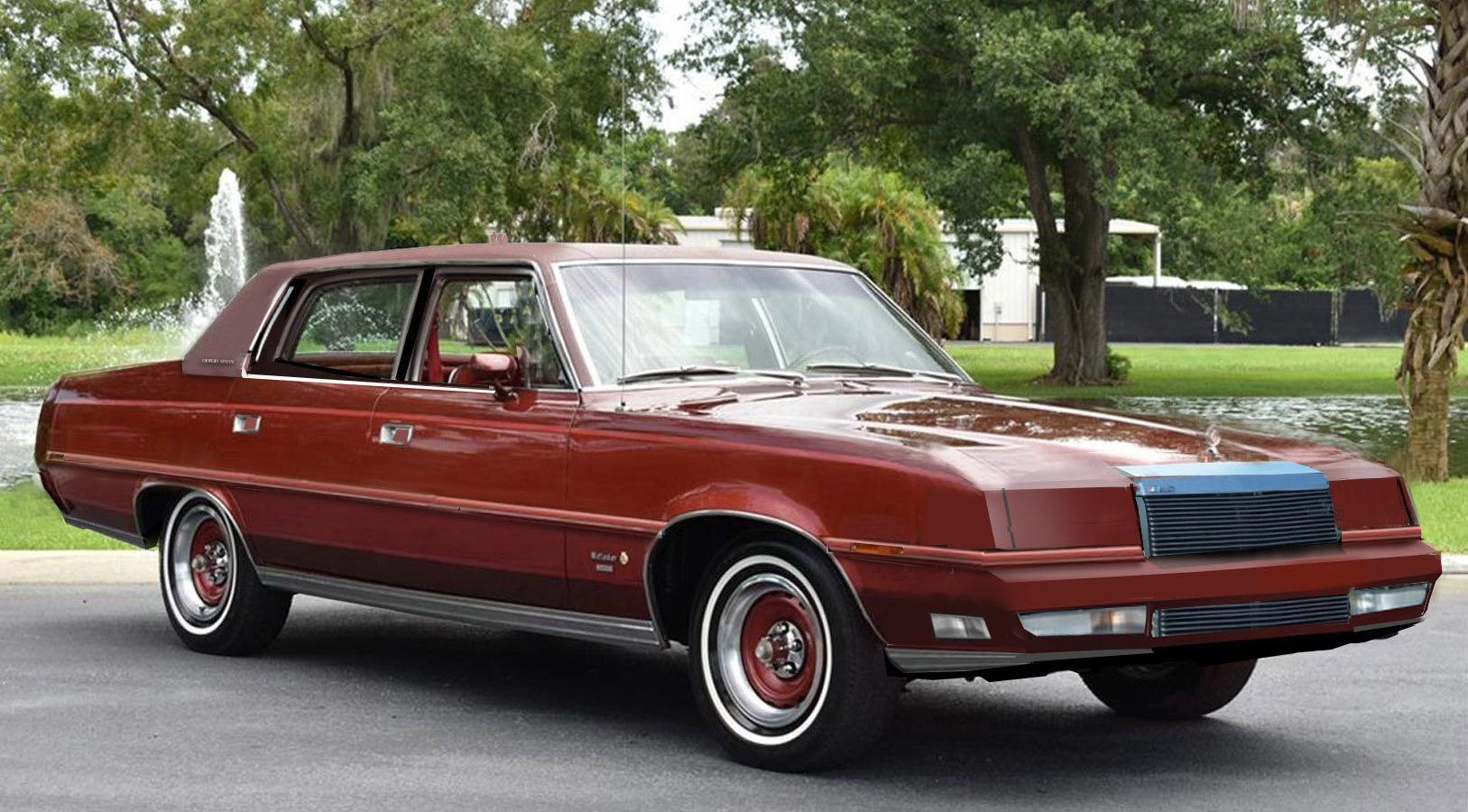
Here’s an animation of all the stuff my time-machined self did:
In back, the ”loop” shaped flexible body-colored rear fascia holds blacked-out taillights and a slightly modified trunk lid blends the area in:
The obligatory animation of the Matador and the Montpelier:
Oh, sure, it looks like a baroque pimp mobile, but as I sneak out the door, I just know that the design team will see that the Matador isn’t worth giving up on yet. You think the dolled-up Hornet they called the Concord was a hit? Wait until they do the math on the profit margin of these cheap add-ons.
Halston, Gucci, Fiorucci…
How about interior trim for our Montpelier? Hey, now you’re talking AMC’s language! Remember the simulated Levi’s fabric seats in a Gremlin?
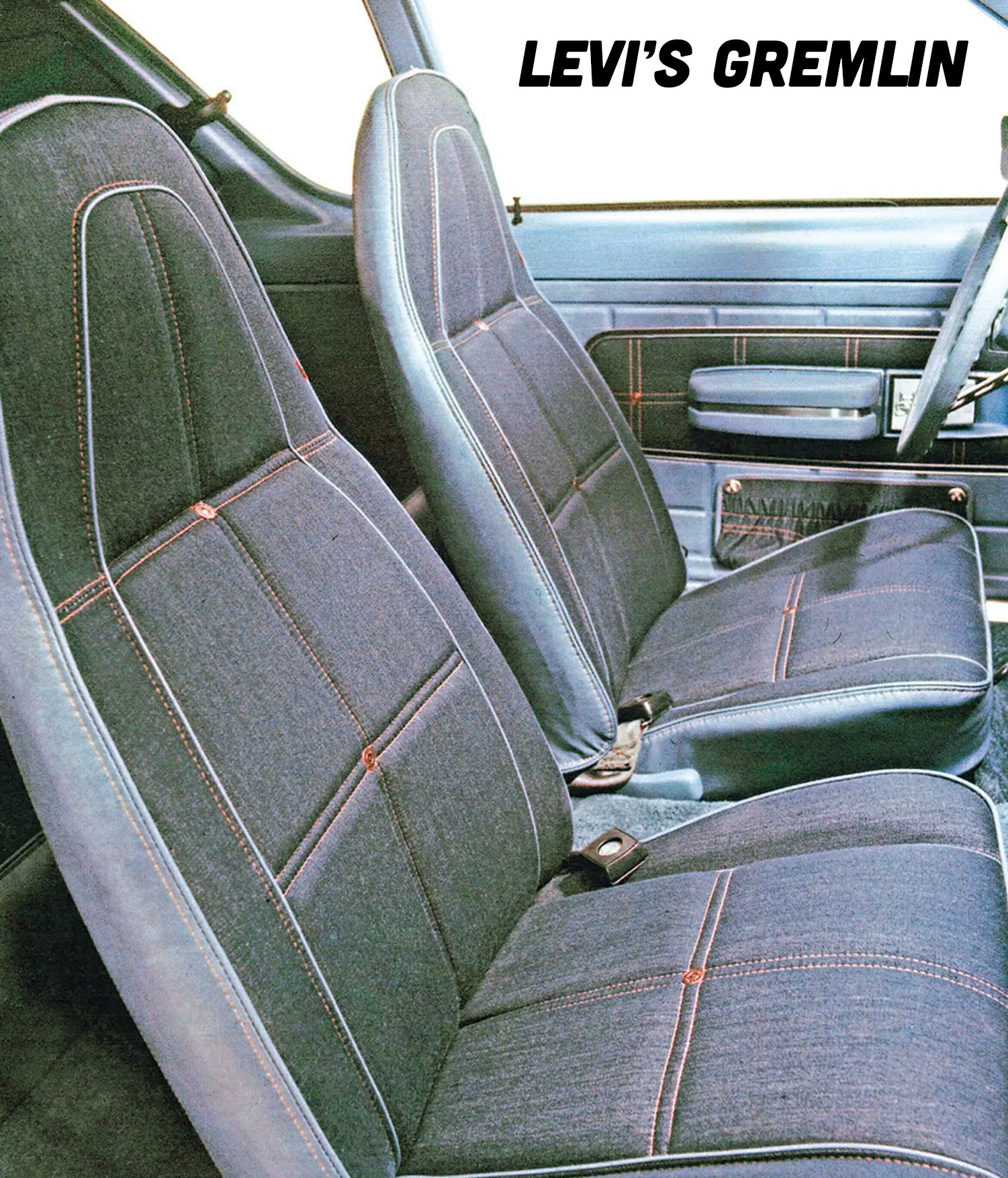
How about the Pierre Cardin or Oleg Cassini package and Gucci Hornet?

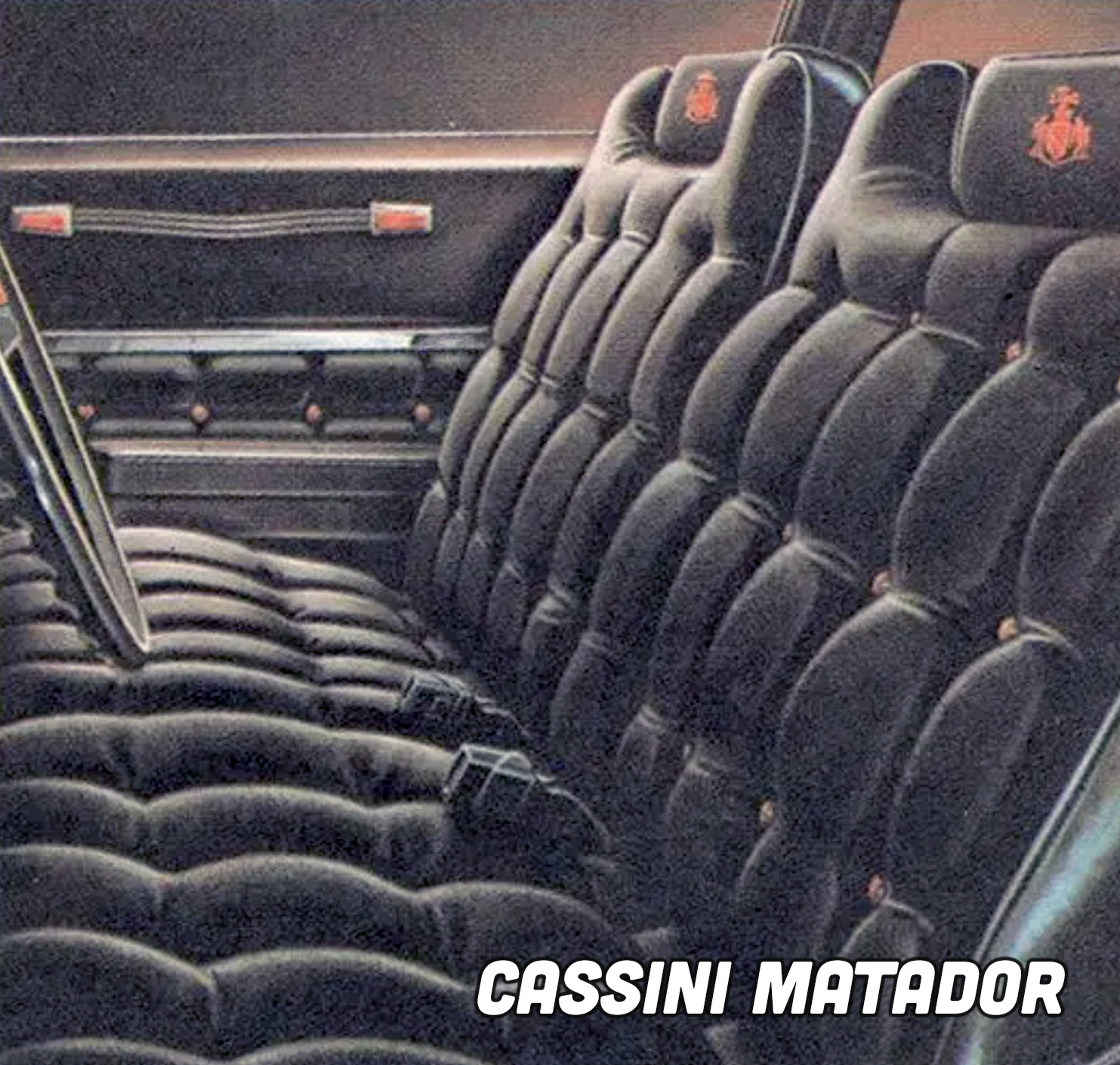


That’s some fun stuff there. Naturally, a few years later, Ford made “Designer Series” Lincolns in a move that seemed to rip off what American Motors had already done so well. Ripping off AMC has always been a thing, right?
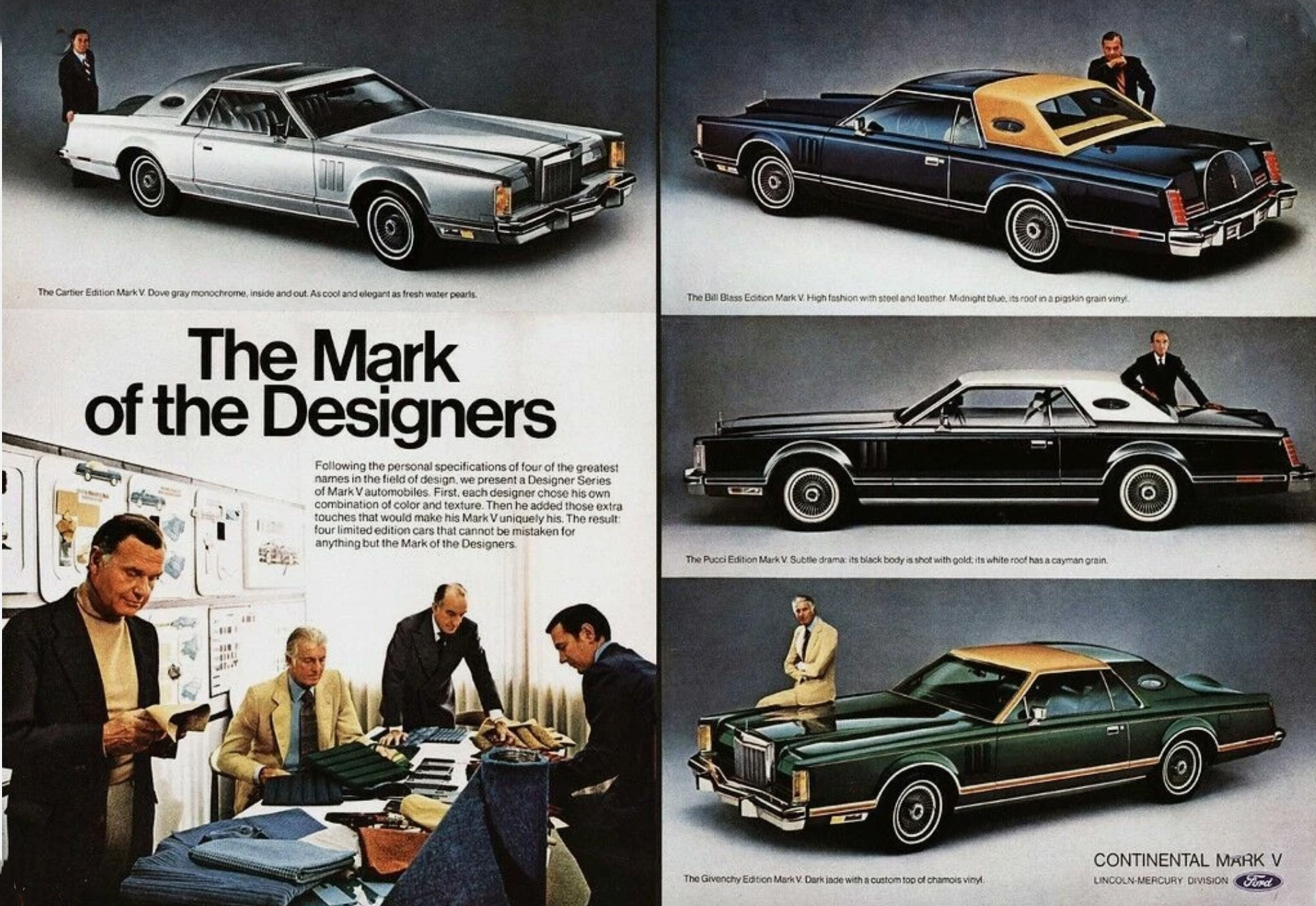
The AMC team could make magic again on this reimagined Matador by recognizing up-and-coming clothier Giorgio Armani and his understated seventies tweed-like collection for a hard-wearing but tastefully appointed cabin. The exterior changes I’ve shown to make a Matador into a Montpelier would leave little money for interior modifications; I do my best with as little as possible. Here’s the original:

Before I run from the design studio, I leave a scribble with the interior changes on the front seat. My plan is to first rip out the ancient gauge cluster with woodgrain gauges (no, they really were) and replace them with a panel featuring a digital speedometer, fuel gauge, and clock with a few trip or fuel economy functions.
Electronics were nowhere near as cheap fifty years ago as they are now, but such space-age additions would pay big dividends and likely still undercut the cost of tooling up a whole new dash. Imagine the flex of a digital dash in 1979! Add-on pods to integrate the power window and lock switches into the doors are mandatory for a fancy road locomotive.
Yes, that extended roof cap in back needs to be covered by rear headliner trim, but it’s well integrated and even features vanity mirrors on the side pillars like a Silver Shadow.
Again, it’s stupid little details like that and padded headrests that add pennies to the build cost but make buyers feel special. “Look, Sheila, our new car is just like a Rolls-Royce”.
One last thing before I head back to the time machine: a mechanical suggestion. Dick Teague has stated that nobody would pay attention if AMC didn’t offer a twist that made them stand out against the Big 3 competitors. What could they have offered that the others didn’t? Or, in this case, they did offer but in the worst way possible? I smell diesel fumes, people.
Pocketa Pocketa Pocketa…
Naturally, the standard 258 cubic inch inline six of the last Matadors wouldn’t have attracted many buyers, and we know that our David Tracy is not a big fan of the available 360 V8. AMC would need something more to get those prospective Olds 98 and Buick Deuce-And-A-Quarter insurance executives.
After the first fuel crisis in the seventies, diesel cars became far more in demand; this popularity increased exponentially after the second gas crunch in 1979. The Oldsmobile 5.7-liter diesel V8 proved irresistible at first before quickly becoming a historic reliability disaster for GM. Once again, it would have been an ideal time for scrappy American Motors to scour the globe for an oil-burning powerplant for one of their cars and beat the Big Three.
Evidence suggests that they tried on one of their Hornet variants. AMC apparently provided a “factory authorized” diesel option for the 1980 Eagle with a VM Motori-built turbo diesel six cylinder.
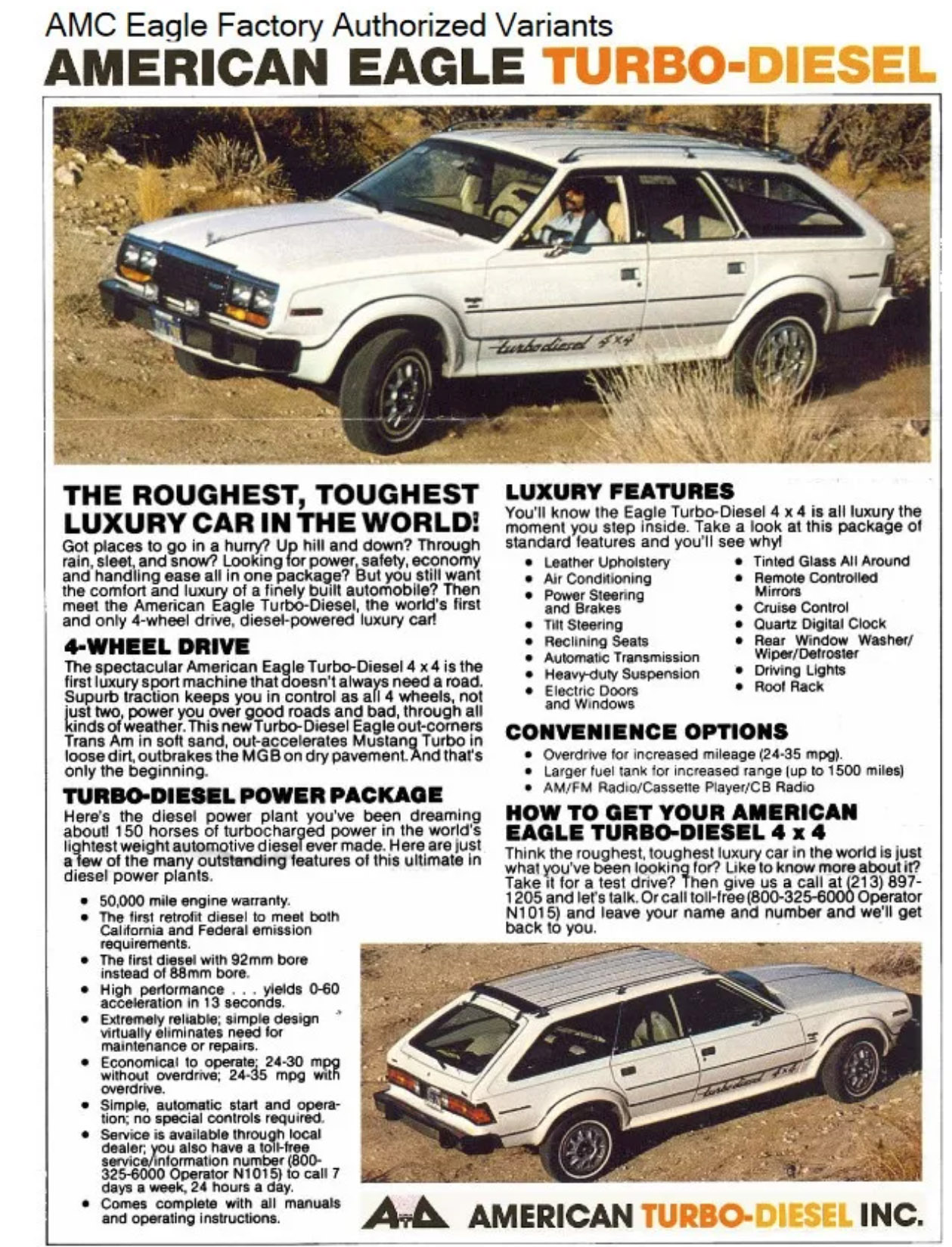
That was a real thing! The 150 horsepower the motor pumped out doesn’t seem like much today, but that’s fifty percent more than GM got from their ill-fated diesel V8 (and more than the standard gasoline six in the Eagle) with better fuel economy. It’s actually 150 percent more power than the GM diesel got when the head bolts on that piece of crap snapped, or the crank broke, or the diesel pump failed, or water got in the tank..
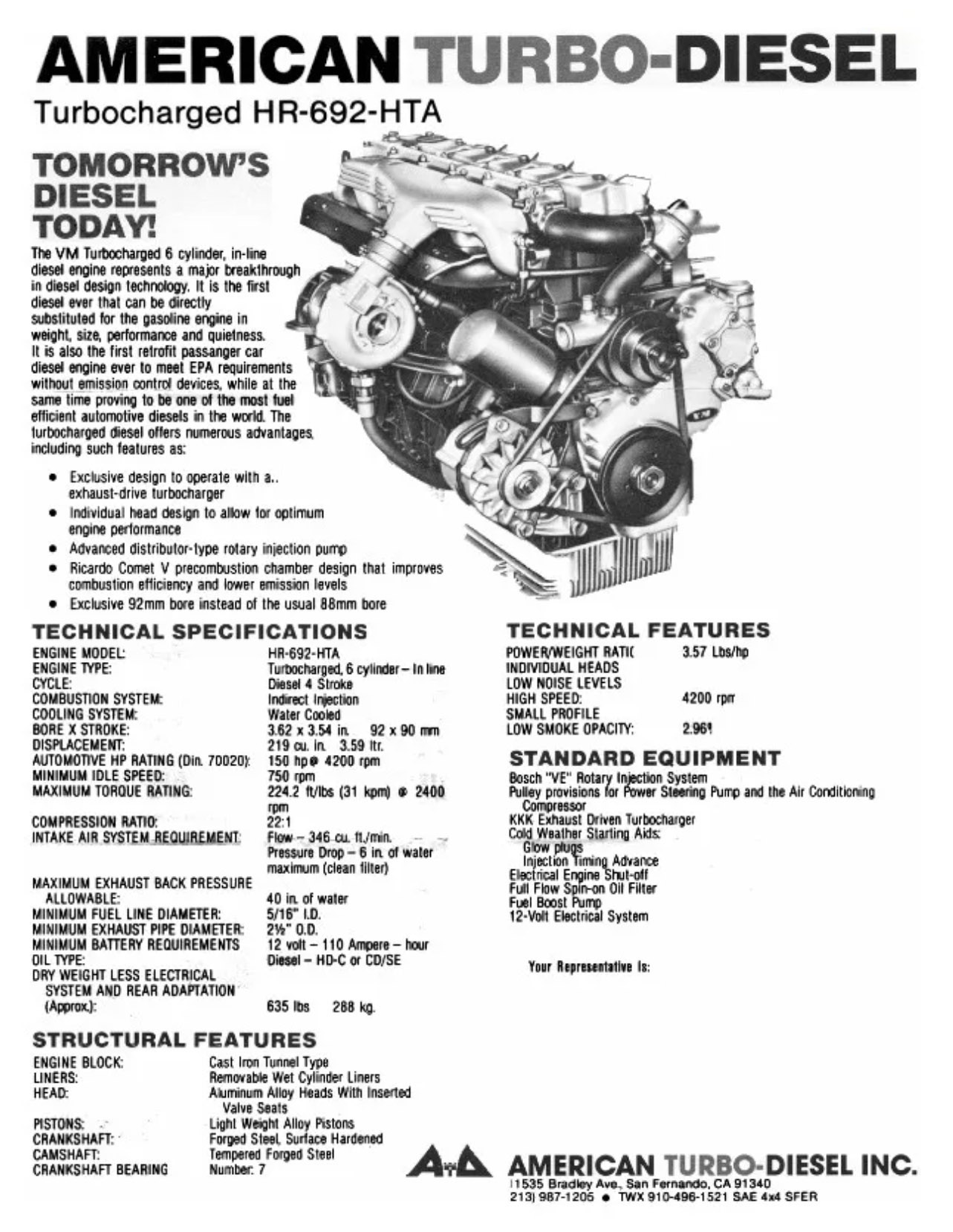
Sadly, the conversion essentially doubled the price of the Eagle and put it close to Mercedes territory; only ten Eagles were reportedly converted before the whole experiment dissolved.
Still, there’s nothing to say that such a motor option (or something from Cummins or Perkins) couldn’t be done cost-effectively in quantity. Plus, it’s a turbo diesel, and “turbo” makes anything better, right? Speaking of Mercedes, they were the only maker offering a turbocharged diesel car in 1979. Time for a classic seventies-style comparison ad!
Sure, nobody was going to cross-shop a Mercedes 300SD with a Barcelona, but it wouldn’t have hurt to compare the two “turbo diesel luxury cars” in typical AMC style.
Cadillacs, Lincolns Too, Mercury (But Not) Subaru
Could we really take a 1967 car and refine it enough to be competitive in 1978? They certainly did that with the Hornet, providing what seemed like better value for the money than the Big 3, plus that turbo diesel technology is something that they wouldn’t offer for years.
Would I choose a 1979 AMC Montpelier Turbo Diesel Giorgio Armani Edition? Maybe not, but I can see a lot of budget-conscious American buyers taking a look at it. At the very least, it would win out over the old Matador … by a nose.













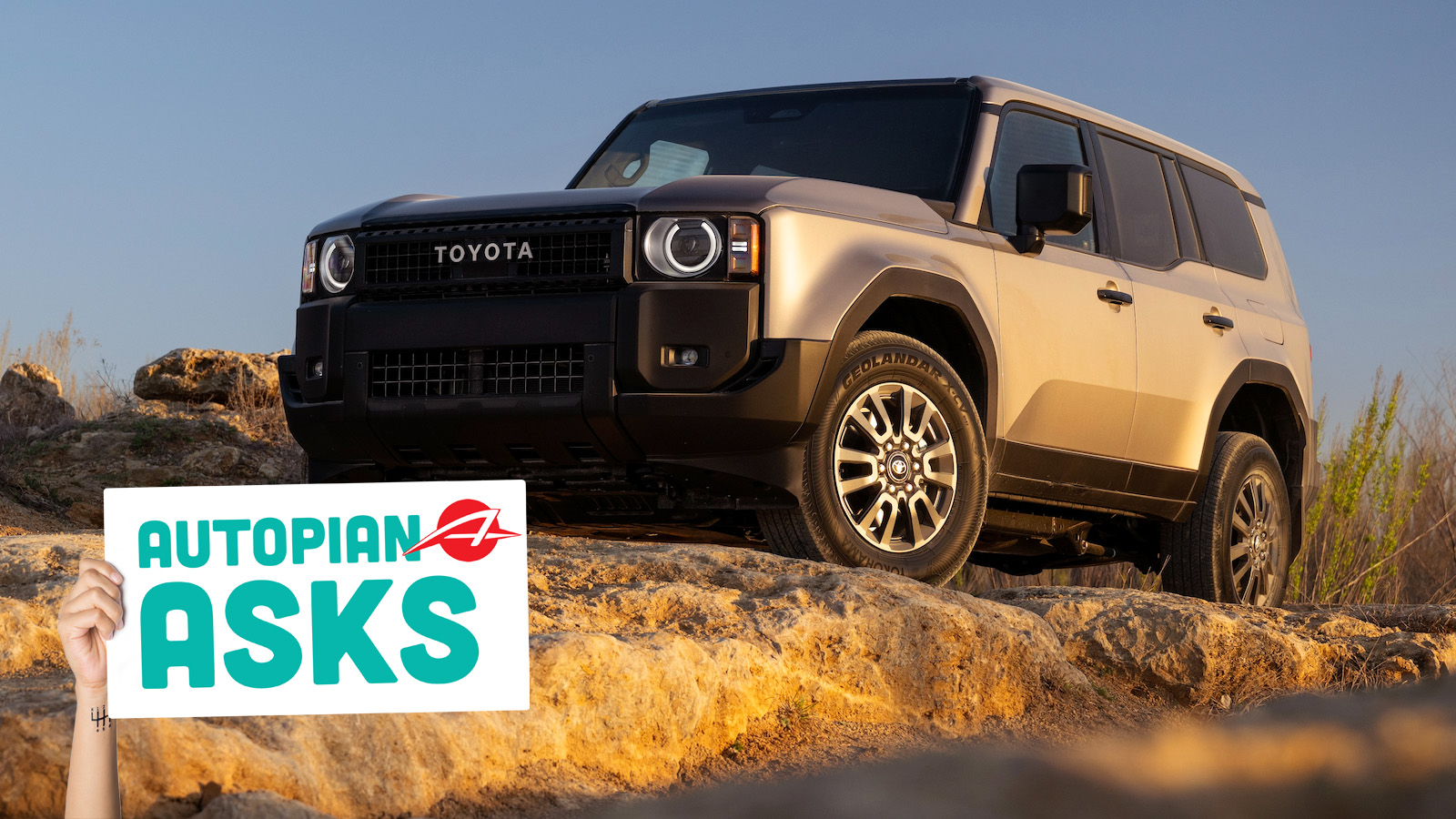
Weird, just this morning I was down a rabbit hole about the history of these cars. I remember one of the car mags describing AMC’s offerings as “cursed with an internal weirdness.” Pretty much.
I love what you did here. I’ve got to say I really like the wheels. No wonder you didn’t touch them.
I like the render Bishop. It would have been in line with the 79 & 81-83 imperial. Which especially that latter looked sweet.
by that time, the Renault 25 was on its way, but AMC waited 5 years to sell it here!
Had they sold the 25 when they launched it in Europe, under either name Renault or AMC, it would’ve been more successful and also better than your rendering.
Also, why didn’t you give the rendering amber turn signals? 😛
The tan two tone AMC Eagle reminded me of a former coworker who stopped by my office after work and asked for a couple of wire coat hangers. The exhaust on his AMC Eagle was sagging, and he needed to wire it up so he could drive home. About 45 minutes later he came to my office again asking for help, as his car mysteriously wouldn’t move.
I went outside and discovered he had wired the exhaust to a nearby u-joint yoke. When he put the car in reverse and gunned the engine, he wrapped the exhaust system around the driveshaft and wedged everything against the chassis. I tried not to laugh while gently explaining a borrowed pair of pliers wasn’t going to quickly fix that mess.
Looks good with the facelift Bishop! I never understood why AMC didn’t retain the quad head lamps used on the Ambassador and bless the Matador with them when the Ambassador met the ax. That coffin snoz wasn’t nearly as ungainly with the 4 eyes.
Yeah, that one lasted only one year and for some reason it doesn’t look as bad.
That nose looks like it came off a 1988-1991 Chrysler New Yorker or a 1990-1991 Fifth Avenue.
I’m not sure that American Motors was ready to build a full sized car–or any car for that matter–without massive chrome bumpers at that point.
The grille and covered headlamps were of the time. I agree about the bumpers, chrome was still the std except for a few sport models. The ’78 Dodge Magnum may have had the first urethane bumpers in a car about this size.
I see a K body Imperial – and that is not a bad thing!
The Magnum had chrome bumpers through 1979 but the 1980 Dodge Mirada had urethane bumpers up until it was discontinued in 1983.
Interestingly its more luxury oriented platform mate the Cordoba still had chrome front and rear bumpers. I don’t think AMC would have been the manufacturer to be the innovators when it came to bumper technology in 1978.
It reminds me most of the 92 LeBaron convertible that was my first car. Similar chrome rectangular grille and covered headlights
The interior cheapening in cars is always a sore point for me. My ’91 Sable GS was honestly in some ways better equipped than my top of the line ’94 SHO. It had no moonroof but did have rear seat adjustable headrests. Same with my ’96 Camry LE (rear adjustable headrests and fabic cover door cards) vs my current ’14 Camry SE hybrid. These little details matter. My wife’s ’07 Corolla has better interior touch points than a newer one. Decontenting is real. My ’99 Grand Cherokee Laredo was far better equipped than the ’03 Laredo my wife’s cousin owned.
Keep fighting the Man!
Interior appointments and touch points were the biggest difference between dad’s old ’85 Colony Park wagon and his ’90 Town Car. Both Panthers with first gen suspension and OHV 302 engines. To be honest the interior of his ’96 Town Car was a downgrade, as well as the ’03 Grand Marquis – even if they had better chassis, brakes, and 4.6 motor?
I don’t want to have to buy Acura/Lexus for what was once std Honda/Toyota trim 20 years ago.
From my ’07 Pilot to my ’10 Pilot…oof.
Congratulations, you’re created the Eagle Premier! Or was it the Medallion? I forget.
What? No love for the Monaco?
The Monaco was one of those… probably the Premier?
I don’t know my Renault numbers.
The Monaco was a rebadged Eagle Premier which was a restyled Renault 25 with a massive trunk instead of a hatchback.
I worked on one once – it was – interesting.
There’d be no need to tool up new rear doors for this or hide the kickups. Just use the wagon rear doors. Likewise use the ’74 Ambassador front as a jumping off point.
And as hilarious as I, a Vermonter, find Montpelier as a car name with its invitation to comparison of the leaky roof cap’s effect on the carpets with how downtown, right on the banks of the Winooski River, floods with depressing regularity, I think if AMC was going upmarket they’d revive the Ambassador name for this.
I’m assuming it refers to James Madison’s estate in West Virginia
But, I could see going back to Ambassador, or, if you want something French sounding, go further back into Nash’s history and call it the Lafayette
It could mean that but I was looking at the Vermont town. You know, with Concord, AMC would need to find more New England fall getaway type names.
You know, it never actually occurred to me that the Concord was named after Concord, Massachusetts, but it apparently was.
I guess Chrysler muddied the waters a bit later with their Concorde, though in all fairness, they did have the name first
Your front treatment is giving me Chrysler and/or Lincoln vibes, but I can’t quite put my finger on it at the moment. I’ve got to go catch a plane, so I can’t do a deep dive on that.
Anyway, it looks a lot better that way.
’90s LeBaron convertible with headlight covers.
No, 1990 Imperial
’91 New Yorker
From glancing at the top picture, I assumed this was a car for after AMC was absorbed into Chrysler. That front end screams Chrysler to me.
I like the front and rear ends. Not loving the new roof line. Overall it’s a tremendous improvement.
New dream vehicle desire unlocked: an AMC Eagle Wagon with an AX-15 and an MB OM617 turbodiesel 5-pot swap.
I would spend the money on another AMC / James Bond tie-in.
That’s a bridge too far for me.
Like, Thailand far.
I would totally get a turbo-diesel montpelier if one actually existed today. I’d still have to have a corolla or rav4 handy because the montpelier can be a fickle beast sometimes.
“Halston, Gucci, Fiorucci…” I am among the possible half-dozens of readers who get this reference. The car would be a lost cause. However, Adam (IYKYK) on his classic car YouTube page showed a concept clay model of a potentially refreshed Concord with a revised upright roof, redone tailights and a few other tweaks that were envisioned to keep the old Hornet platform going a few more years.
I did see that Concord as well!
That heading is hyperlink by the way- click on it for some Nile Rodgers goodness.
I keep forgetting that song is not Chic, and I mix up my “Halston, Gucci, Fiorucci…” with “clams on a half-shell, and roller skates.” Good times.
The body coloured bumpers push this too far into the future. Chrome or nickel plated steel was still the thing up until about 1985 (and those cars were finalized in 1982) so this definitely would’ve had the same if it was finalized in 1977 and went on market in late 1978. Even the early K-cars still had metal (or metal accented) bumpers, despite the underlying structure being plastic.
The other thing is that the turbodiesel was seen as the “hardy” engine for strange applications. It rattled and clanked and made weird whooshing noises that scared the corn fed midwesterners. If anything AMC would’ve kludged the 258 in there and touted the “computer controlled fuel delivery’ that the Spirit was marketed with in order to garner positive comparisons against the Cadillac Seville. The Seville at the time was seen as the high tech Cadillac with an emphasis on fuel economy, which would’ve likely been the target.
Giorgio Armani would’ve been a risk as the brand was too little known and wouldn’t have hit U.S. stores until about 1981. LaCoste, who at the time would’ve taken any brand deal they could’ve to keep away from bankruptcy, would have been the one I’d expect AMC to approach, because they could’ve put the gators on the Montpelier and put the budding Izod sport bars on the Jeeps (LaCoste owned stake in Izod at the time).
Huh?!? Let me introduce you to the 1979 Ford Mustang:
https://www.autoevolution.com/cars/ford-mustang-1979.html#aeng_ford-mustang-1979-23
…and the 1976 Pontiac Firebird:
https://www.autoevolution.com/news/dealer-sells-1976-pontiac-firebird-w50-formula-in-fantastic-shape-unrestored-239517.html
There’s the ‘Vette too, Chevy Laguna (1974), a bunch of Pontiacs,
The Mark VII still had chrome bumpers (although the Fox body T-bird/Cougar siblings did not). I do think Dodge first moved away from chome bumpers on big cars with the Magnum in ’78.
For a full size luxury vehicle though? No, the prevalent styling was still neo-classical chrome everything. That’s what this refresh is designed around. Even the Chrysler R-bodies of 1979 that this pulls from still had chrome bumpers.
There would need to be some serious mental gymnastics to justify buying both the fuel economy minded turbo diesel AND the Giorgio Armani luxury interior package.
Hey, there was a Givenchy Lincoln Continental with a BMW Turbo Diesel for a year or two. Check it out!
Fuel economy wasn’t just about saving money back then, people were afraid of fuel shortages, as happened in 1973 and 1979. Even buyers too rich to care what gasoline cost suddenly started caring about mpgs when the concern was over gas just not being available at any price
I was born in ’76. Dad downsized to a 6cyl Fairmont in ’81? during the second fuel crisis. I remember gas costs and availability still being a THING in my youth.
You’ve made it. Get the full Monty.
Ok but my favorite band has a song called ‘Matador’ so I’m obliged to share that here.
https://www.youtube.com/watch?v=kGuJu6i0vLU
Lee Iacocca would be proud to have this in his fleet
Glad to hear it…always wanted to be a land yacht ninja
He was the land yacht Godfather.
I like the OG Matador nose.
The design is okay, but I don’t see anything there that would pull buyers away from Chrysler/FoMoCo/GM dealers, so why bother?
In fact, the decision of Rambler/AMC to try to compete model-for-model with the Big 3 was the fatal decision that killed the brand. When Ramblers were unusual or cheaper than the Big 3, they did some business, but when they tried to compete head-on, they failed.
I’ll tell you how to pull in buyers- standard factory air conditioning, standard factory Ziebart treatment, a 5 year/50,000 mile Buyer Protection Plan, and ultra low 13.1% financing for 36 months with approved credit
Besides the all too common undersized tires and rims in most malaise era cars, the only thing the 2 door matador really needed was to immediately remove both the front and rear bumpers. https://barnfinds.com/304-v8-equipped-1974-amc-matador-coupe/
That thing was far more of an attractive personal luxury barge with sports flair than it seemed to be with the logs tied onto it front and back.
I’ve seen a number of those out there, and yes, they look surprisingly better. Still too weird for the average buyer, but I flat out love them.
Dick Teague had ambitions of redoing the entire Matador line with the Coupe’s styling and drew up proposals for a sedan version, but the money just wasn’t there. The Matador Coupe and Pacer had exhausted all the company’s funds, and although they both sold deceptively well at first, those volumes ended up not being sustainable and they never came close to earning back the investment
yeah, it was really too bad. I would have probably liked a 401 powered AMX from the coupe. I always did like the Javelin and AMX 1st gen 68-70. https://www.curbsideclassic.com/wp-content/comment-image/538103.jpg
This would have actually sold…